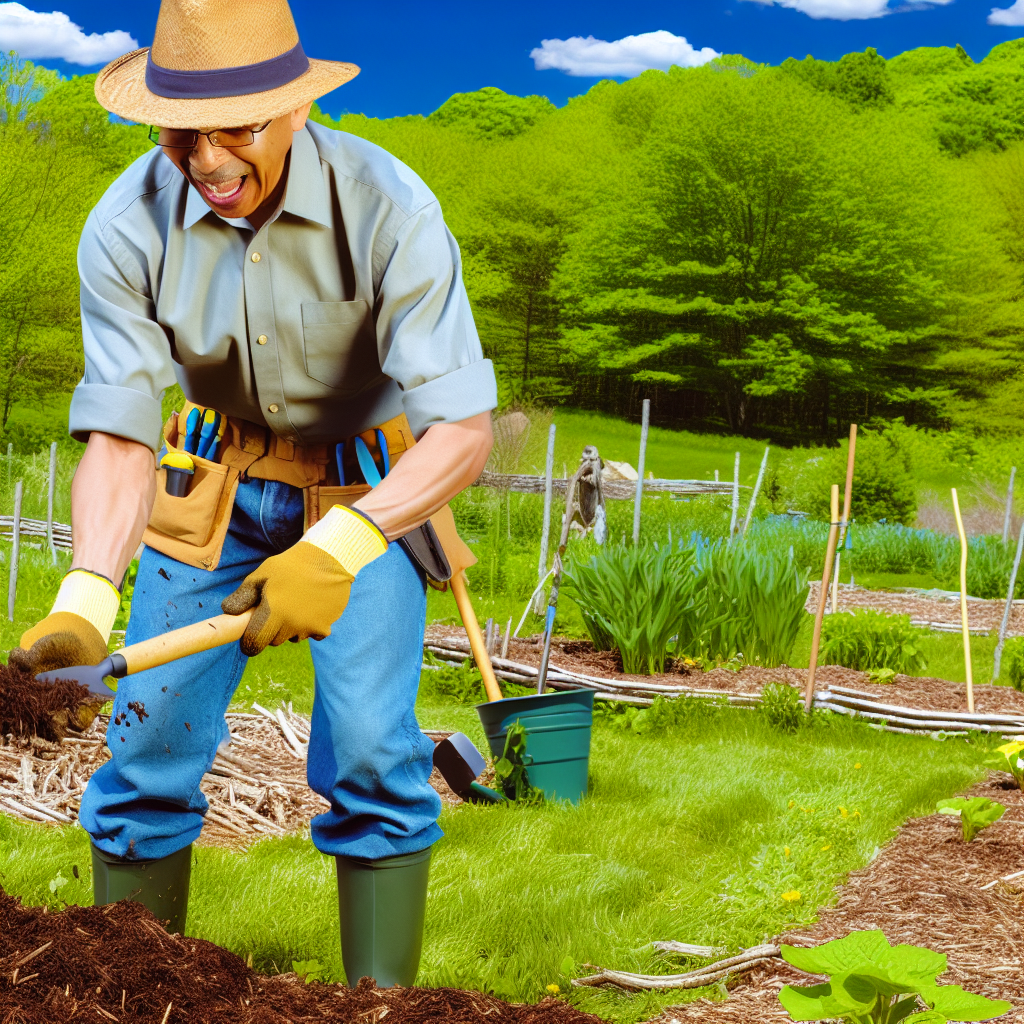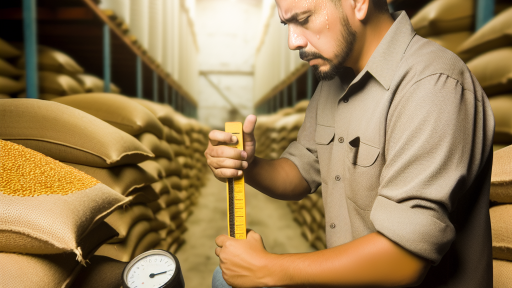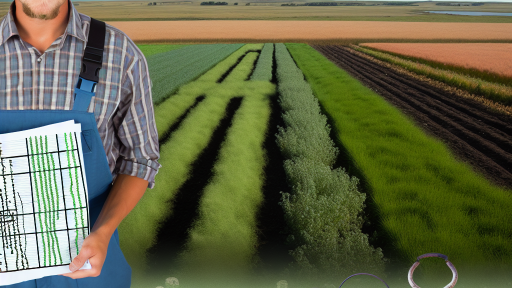Introduction to Seasonal Mulching and Its Importance in Agriculture
Seasonal mulching plays a vital role in modern agriculture.
Farmers utilize this technique to enhance crop productivity.
Mulch acts as a protective layer for soil and plants.
This method conserves soil moisture and improves its fertility.
Moreover, mulching suppresses weeds effectively.
By controlling weeds, crops have a greater chance to thrive.
Using mulch also helps regulate soil temperature.
This regulation creates a more stable environment for crops.
In addition, seasonal mulching supports beneficial soil organisms.
These organisms contribute to healthier plant growth.
Farmers can choose from various mulching materials.
Common materials include straw, wood chips, and grass clippings.
Each type of mulch offers unique benefits.
Ultimately, the choice depends on specific crop needs and local conditions.
Seasonal mulching is essential for sustainable farming.
Transform Your Agribusiness
Unlock your farm's potential with expert advice tailored to your needs. Get actionable steps that drive real results.
Get StartedIt creates optimal conditions for successful harvests.
Types of Mulching Materials
Organic Mulching Options
Organic mulching materials come from natural sources.
They improve soil health and fertility over time.
Common organic options include straw, grass clippings, and shredded leaves.
These materials decompose and enrich the soil with nutrients.
Furthermore, they help retain moisture during dry spells.
They also suppress weeds effectively.
Inorganic Mulching Options
Inorganic mulching materials do not decompose.
Common examples are plastic sheeting, gravel, and landscape fabric.
Plastic sheeting provides excellent weed control.
It also helps warm the soil for early planting.
On the other hand, gravel adds a decorative touch.
However, it does not improve soil fertility.
Choosing the Right Mulching Material
Selecting the right mulching material depends on your gardening goals.
Consider factors such as cost, availability, and aesthetic preferences.
Organic options are great for sustainable practices.
Inorganic materials may be ideal for long-lasting applications.
Each type has its unique benefits and considerations.
Ultimately, the right choice can boost your garden’s productivity.
Benefits of Mulching for Soil Health and Moisture Retention
Enhancing Soil Structure
Mulching improves soil structure significantly.
It adds organic material that benefits microorganisms.
Consequently, the soil becomes more porous and airy.
This improved structure helps roots grow deeper.
Moisture Retention
One of the main benefits of mulching is moisture retention.
Showcase Your Farming Business
Publish your professional farming services profile on our blog for a one-time fee of $200 and reach a dedicated audience of farmers and agribusiness owners.
Publish Your ProfileMulch acts as a barrier against evaporation.
This keeps the soil hydrated longer during dry spells.
As a result, plants access moisture more efficiently.
Additionally, consistent moisture aids seed germination.
Weed Suppression
Mulching significantly suppresses weed growth.
A well-mulched garden allows desirable plants to thrive.
It blocks sunlight that weeds need to germinate.
Thus, less competition arises for nutrients and moisture.
Temperature Regulation
Mulch helps to regulate soil temperature.
It keeps the soil warmer during cold seasons.
This is particularly beneficial for vulnerable plants.
Furthermore, mulch provides insulation from extreme heat.
This stability promotes healthy plant growth.
Reducing Soil Erosion
Mulching plays a vital role in preventing soil erosion.
It protects the soil surface from wind and water runoff.
This protection maintains valuable topsoil layers.
Consequently, soil productivity remains unaffected.
Fostering Beneficial Soil Microorganisms
Organic mulch encourages beneficial soil microorganisms.
These microorganisms break down organic matter effectively.
The decomposition process enriches soil with nutrients.
Healthy soil microorganisms promote overall plant health.
Creating a Balanced Ecosystem
Using mulch contributes to a balanced ecosystem.
It attracts earthworms and other soil fauna.
These organisms improve soil health through their activities.
Moreover, a balanced ecosystem supports biodiversity.
See Related Content: Building Soil Organic Matter for Farmers
Seasonal Considerations: Choosing the Right Mulch for Each Season
Spring Mulching Techniques
Spring is a crucial time for garden prep.
Choosing the right mulch can greatly enhance plant growth.
Organic mulches, such as shredded bark or straw, work effectively in spring.
They retain moisture and suppress weeds during warmer months.
Furthermore, they enrich the soil as they decompose.
Summer Mulching Strategies
In the summer, mulching is essential for moisture conservation.
Opt for light-colored mulches to reflect heat.
Wood chips or gravel are great options to keep soil cool.
Additionally, these materials prevent soil erosion during heavy rains.
Regularly check moisture levels to adjust mulch thickness as needed.
Autumn Mulching Choices
As temperatures drop, autumn mulching becomes critical.
Use mulches that provide additional insulation to the soil.
Dry leaves or straw are effective for this purpose.
They create a protective layer against frost.
Showcase Your Farming Business
Publish your professional farming services profile on our blog for a one-time fee of $200 and reach a dedicated audience of farmers and agribusiness owners.
Publish Your ProfileMoreover, they can suppress weeds emerging in the fall.
Winter Mulching Recommendations
Winter presents unique challenges for gardeners.
Insulating mulches should be used to protect roots from freezing.
Consider using pine needles or mulch mats for this purpose.
These options trap air, providing warmth to plants.
Also, remove any heavy snow accumulations to prevent damage.
See Related Content: Data Analysis Tools For Disease Forecasting In Farming
Mulching Techniques for Climate Resilience in Different Regions
Understanding the Importance of Mulching
Mulching plays a crucial role in sustainable agriculture.
It helps retain soil moisture and reduces erosion.
Furthermore, mulch contributes to soil temperature regulation.
Using mulch improves soil health by adding organic matter.
Cool Climate Mulching Practices
In cooler regions, thick layers of mulch insulate the soil.
This protects plants from harsh winter conditions.
Wood chips or straw make effective mulching materials.
They decompose slowly, providing nutrients over time.
Spring Preparation Techniques
In spring, remove old mulch to promote new growth.
Apply fresh mulch to prevent weeds from taking over.
Consider adding a layer of compost to enrich the soil.
Warm Climate Mulching Strategies
In warmer regions, mulching conserves moisture during droughts.
A layer of straw or grass clippings works well.
These materials reduce soil temperature and retain water effectively.
Managing Pests Naturally
Mulching can help deter pests and diseases.
Ensure your mulch is clean and free of pathogens.
Regularly monitor for any signs of pest activity.
Tropical Region Techniques
Tropical areas benefit from organic mulches like coconut husks.
These materials add nutrients and improve soil structure.
Apply mulch early in the rainy season for best results.
Enhancing Soil Fertility
In these regions, mulching can significantly enhance soil fertility.
Organic matter improves water retention and nutrient availability.
This results in healthier and more productive crops.
Dry Climate Mulching Methods
In arid regions, mulching is essential for moisture conservation.
Use rocks or gravel as effective drought-resistant options.
These materials limit evaporation from the soil surface.
Seasonal Adjustments
Adjust your mulching strategy according to seasonal changes.
In winter, a thicker mulch layer provides extra insulation.
In summer, thinner layers allow for moisture retention.
Benefits of Using Native Materials
Using native plant materials for mulch supports local ecosystems.
They are generally more resilient to regional climates.
Moreover, they promote biodiversity in the landscape.
Cost-Effective Solutions
Local materials can reduce costs associated with mulching.
Showcase Your Farming Business
Publish your professional farming services profile on our blog for a one-time fee of $200 and reach a dedicated audience of farmers and agribusiness owners.
Publish Your ProfileThey are often more sustainable and environmentally friendly.
This approach minimizes transportation impacts and resources.
Learn More: Benefits Of Accurate Disease Forecasting For Farmers
How to Apply Mulch: Best Practices for Effective Coverage
Selecting the Right Mulch Material
Choose organic material for gardens and vegetable patches.
Consider using bark, straw, or wood chips.
For flower beds, opt for shredded leaves or compost.
Ensure the mulch material is free from diseases and pests.
Preparing the Soil
Begin by clearing away any weeds or debris.
Loosen the soil to improve aeration and water penetration.
Test the soil pH and amend it as necessary.
Moisten the soil before applying mulch for better adherence.
Applying Mulch Evenly
Spread mulch in a uniform layer across the soil surface.
A recommended depth is two to four inches, depending on the material.
Avoid excessive layering, which can suffocate plant roots.
Leave space around the base of plants to prevent rot.
Timing Your Mulching Application
Apply mulch in early spring to suppress weeds effectively.
In fall, add mulch to protect plants from frost and winter chill.
Monitor soil moisture levels to determine if a reapplication is needed.
Maintaining Your Mulch Layer
Check for decomposition and replenish as required.
Remove any weeds that break through the mulch layer.
Rake the mulch periodically to aerate and refresh its appearance.
Adjust the mulch thickness with the changing seasons.
See Related Content: Hydroponics Systems Explained

Maintaining Mulch Throughout the Growing Season
Mulch Selection
Select the right type of mulch for your plants.
Organic mulches add nutrients to the soil as they decompose.
Inorganic mulches offer long-lasting weed control without enriching the soil.
Consider using a combination for best results.
Application Techniques
Apply mulch in a layer 2 to 4 inches thick.
A thicker layer retains more moisture and suppresses weeds better.
Ensure mulch does not touch plant stems to prevent rot.
Use a rake to distribute mulch evenly around your plants.
Regular Maintenance
Check your mulch layer regularly throughout the growing season.
Add more mulch as it decomposes or gets displaced.
Break up compacted areas to allow for better air circulation.
Remove old mulch if it shows signs of disease or pest infestations.
Watering and Mulch Interaction
Water your plants thoroughly before applying mulch.
This helps to settle the mulch into place.
Regularly check soil moisture under the mulch layer.
Adjust your watering schedule based on the mulch’s moisture retention.
Seasonal Adjustments
Consider changing mulch materials with the seasons.
Showcase Your Farming Business
Publish your professional farming services profile on our blog for a one-time fee of $200 and reach a dedicated audience of farmers and agribusiness owners.
Publish Your ProfileFor winter, a thicker organic layer can provide insulation.
In spring, mix in fresh mulch to rejuvenate your garden beds.
Be prepared to remove or thin layers as temperatures rise.
Case Studies: Successful Implementations of Seasonal Mulching
Farm to Table: The Rivera Family’s Organic Produce
The Rivera family adopted mulching techniques three years ago.
Their farm produces organic vegetables and fruits.
They use straw and wood chips as mulch materials.
This approach effectively retains soil moisture.
Additionally, it suppresses weed growth significantly.
As a result, their harvests increased by 30% annually.
Customers appreciate the quality of their produce.
Through these efforts, the family gained a loyal customer base.
Community Impact: The Green Thumb Initiative
The Green Thumb Initiative implemented mulching in urban gardens.
They utilized grass clippings and leaves as organic mulch.
This method enhanced the soil quality in community plots.
Volunteers reported healthier plants and increased yields.
The initiative also provided educational workshops for locals.
Participants learned about sustainable gardening practices.
This effort significantly improved local food security.
Innovation in Agriculture: Fresh Harvest Farms
Fresh Harvest Farms explored innovative mulching methods last season.
The farm experimented with biodegradable mulch film.
This technique minimized plastic waste in farming operations.
They observed improved plant growth and reduced soil erosion.
Furthermore, the mulch decomposed and enriched the soil.
Farmers are considering expanding this practice next year.
Fresh Harvest Farms set a new standard for eco-friendly agriculture.
Common Mistakes to Avoid When Mulching Your Garden or Farm
Choosing the Wrong Mulch Material
Using inappropriate mulch can hinder plant growth.
For instance, rubber mulch may not enrich soil nutrients.
On the other hand, organic mulches decompose and improve soil health.
Additionally, avoid using materials that may harbor pests or diseases.
Applying Mulch Too Thickly
Over-mulching restricts water and air from reaching plant roots.
Generally, a thickness of two to four inches is ideal.
Ensure the mulch is spread evenly around the plants.
Furthermore, avoid piling mulch against plant stems, which can cause rot.
Ignoring Local Climate Conditions
Different climates require different mulching strategies.
In arid regions, organic mulches retain moisture effectively.
Conversely, in humid areas, it’s crucial to choose airy materials.
Adapting your technique based on local weather will yield better results.
Not Refreshing Mulch Regularly
Mulch decomposes over time and loses its benefits.
Regularly check for thinning or degradation of the mulch layer.
Replenish organic mulch at least once a season to maintain effectiveness.
Showcase Your Farming Business
Publish your professional farming services profile on our blog for a one-time fee of $200 and reach a dedicated audience of farmers and agribusiness owners.
Publish Your ProfileThis practice not only enhances aesthetics but also soil health.
Failing to Control Weeds
While mulch suppresses weeds, some still manage to grow.
Regularly inspect your garden or farm for emerging weeds.
Pull them out by the roots to prevent re-growth.
Continuously managing weeds maintains a healthy garden ecosystem.
Neglecting Soil Preparation
Mulch alone cannot improve soil quality.
Properly prepare the soil before applying mulch.
Amending soil with compost enhances its structure and nutrient quality.
Incorporating this step ensures maximum benefit from your mulch.




